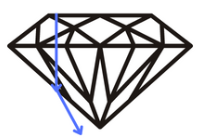The Diamond 4C's
Please take a moment to read more about the significance and definition of these 4 criteria. They will both help you understand a diamond’s characteristics and increase your pleasure during and long after the purchase process.
Every Diamond Is Unique.
The important parameters in grading a diamond as undertaken by Poddar Diamond Ltd.’s grading system are based on the 4 Cs concept. The 4 Cs are:
1. Cut
The cut of a diamond allows it to make the best use of light. When a diamond is cut correctly, light is reflected from one facet to another, then dispersed through the top of the stone. If the cut of the diamond is too deep, some light escapes through the opposite side of the pavilion. If the cut is too shallow, light escapes through the pavilion before it can be reflected. Please do not confuse the cut of a diamond with its shape. Diamonds can be cut into several shapes, depending on the qualities of the rough stone before it is cut. The most popular diamond shapes are round, marquise, pear, emerald, oval, and heart. Whatever the shape, a well-cut diamond is the work of a master diamond cutter. When the cut is right the diamond gives more sparkle.

Ideal

Shallow

Deep
2. Color
Diamonds range in color from faint yellow or brown to very rare pinks, blues, greens, and other colors are known as “fancies.” The best color for a diamond is no color at all. A colorless diamond allows light to pass through it easily, resulting in the light being dispersed as the color of the rainbow. Colors are graded from totally colorless to light yellow. The differences from one grade to the other are very subtle and it takes a trained eye and years of experience to color grade a diamond.
D E F G H I J K L M
3. Clarity
A diamond’s clarity is determined by using a 10-power magnifying glass and a trained eye. Most diamonds contain very tiny impurities known as “inclusions.” An inclusion can interfere with the light passing through the diamond. The fewer the inclusion, the more beautiful the diamond will be. Diamonds have the capability of producing more brilliance than any other gemstone. A diamond that is free of inclusions and surface blemishes is very rare and therefore very valuable.
IF VVS2 VVS1 VS2 VS1 SI2 SI1 I1
4. Carat
This is the weight of a diamond measured in carats. One carat is divided into 100 “points,” so that a diamond of 75 points weights .75 ct. The carat weight of a diamond is the easiest measurement to determine. Most importantly, two diamonds can be of equal carat weight, but their value can differ greatly due to their cut, color, and clarity.